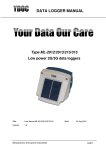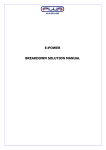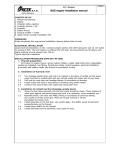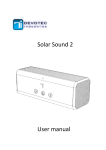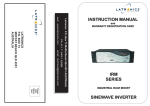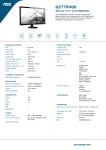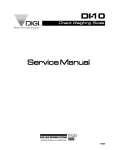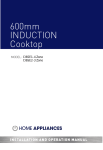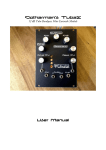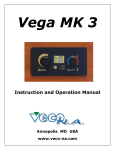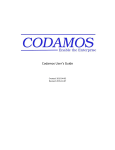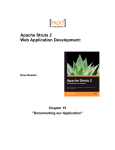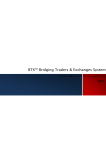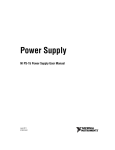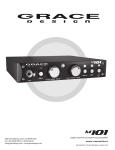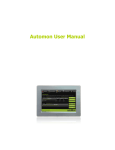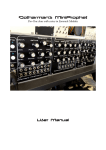Download PowerBoard Manual - Your Data Our Care
Transcript
USER MANUAL TYPE ML2013_power board Type ML-2013 Power Board Title : User guide ML2013 Power Board Version : 0.02 Author : Remco Kleine Manufacturers of low power instruments Date : July 2014 page 1 USER MANUAL TYPE ML2013_power board WARNING THE FOLLOWING OPERATING INSTRUCTIONS ARE FOR USE BY QUALIFIED PERSONNEL ONLY. TO AVOID DAMAGE OR MALFUNCTION, DO NOT PERFORM ANY OPERATING OTHER THAN THAT CONTAINED IN THIS MANUAL. ANY OPERATOR SHOULD BE SKILLED WITH A TECHNCAL BACKGROUND BEFORE OPERATING THE DEVICE. PREFACE Congratulations! With your purchase of the ML-2013 Power Board, for use with the type ML-2013 data logger with GPRS Capabilities. This manual describes the operation and (hardware) installation of the ML-2013 Power Board. We recommend you to read this manual carefully before installation of the ML-2013. TABLE OF CONTETS 1 Product Description ............................................................................................................................... 3 1.1 Contents of the package ............................................................................................................... 3 1.2 Warranty ....................................................................................................................................... 3 2 Editions .................................................................................................................................................. 4 2.1 PB-LI, Lithium input power edition ............................................................................................... 4 2.2 PB-DC, 8..30V DC auxiliary input power edition ......................................................................... 4 2.3 PB-PV, Solar power edition ......................................................................................................... 6 2.4 PB-PV+, Power Booster edition.................................................................................................... 6 3 Pinconfiguration ..................................................................................................................................... 8 Manufacturers of low power instruments page 2 USER MANUAL 1 TYPE ML2013_power board Product Description The YDOC ML-2013-PowerBoard is an accessory to supply power the ML-2013 low power datalogger and acts as GPRS antenna. The PowerBoard is available in several editions: • • • • PB-LI: As holder for a 3.6V Lithium D-size battery PB-DC: As 8..30V DC input with holder for a 3.6V Lithium D-size backup battery PB-PV: Solar circuit to charge 3x NiMH AA batteries PB-PV+ : As PB-BV, but with power booster to power high power demanding sensors. The PowerBoard fist the following ML-2013 covers: • • • • • COVER-LI: Blind cover and PB-LI COVER-DC: Blind cover and PB-DC COVER-PV(+): Cover with integrated 1Wp solar panel and PB-PV(+) COVER-TFT-LI: Cover with integrated touch display and PB-LI COVER-TFT-DC Cover with integrated touch display and PB-DC Properties of the ML-2013 Power Board are: • • • • • • • 1.1 Contents of the package • • • 1.2 Input voltage range 8 – 30 Volts DC 3.6V Lithium D-size battery holder Solar circuit to charge NiMH batteries. Power output Booster Printed GPRS antenna RoHs Compliant CE Compliant ML-2013 Power Board Power Cable (between PCB and Data logger) Ufl-ufl antenna cable Warranty All YDOC instruments are warranted against defective materials and workmanship. Any questions with respect to the warranty mentioned above should be taken up with your YDOC Distributor. Manufacturers of low power instruments page 3 USER MANUAL 2 2.1 TYPE ML2013_power board Editions PB-LI, Lithium input power edition It’s just a printed GPRS antenna and a mounting plate for a D-size Lithium 3.6V battery. We advise to use a SAFT-LS20H 13000 mAh battery because it can supply peak currents required for GPRS communication. 2.2 PB-DC, 8..30V DC auxiliary input power edition The power supply is converting the input power source to a, stable and clean, output-source of 3.6 Volts. It is advised that when a user has a very power demanding configuration, to use this power source, to power of the datalogger. A diode is mounted, for isolation of the (lithium battery). I.E. that no current is drawn, accidentally, from the batteries, into the attached power supply. Your ML-2013PowerBoard has the ideal output-voltage for cooperation with the ML-2013 dataloggers. So: 1) When both, (lithium) battery and auxiliary power are connected, the power will be taken from the auxiliary power only, and thus saving the battery. 2) When the power board is connected, but NOT powered, the ML-2013 datalogger will still continue to work, and draw it’s current from the internal battery. No extra current is wasted into the power supply, by means of the diode. So to increase the availability of your system it is advised to use both battery and Auxiliary power. Protection The power board input circuit is equipped with a tranzorp of 30 Volts, this protects the connected datalogger from high input voltages. Beware of exposing power board to high voltages, as it will damage the fuse. Also, when the polarity of the input-source is wrong, the fuse will blow. But, your connected datalogger is protected in both cases. Normally the fuse will never blow, during the lifetime of the instrument. Manufacturers of low power instruments page 4 USER MANUAL TYPE ML2013_power board Underneath, a picture is shown of a ML-2013 Power Board with Lithium Battery holder and auxiliary DC input power. 1) Battery holder for Lithium Battery (Saft LSH-20) 2) Integrated Quad band GPRS antenna 3) Antenna Connector 4) Power output for powering datalogger (3.6 Volts) 5) 8..30 VDC auxiliary power input connector 6) Fuses for protection (battery and auxiliary) 7) Switched mode Power supply (SMPS) Manufacturers of low power instruments page 5 USER MANUAL 2.3 TYPE ML2013_power board PB-PV, Solar power edition This options enables the use of solar power. It is designed to use with the YDOC solar panel housing. It has a battery holder for 3 AA type NiMH batteries. These batteries are charged from the solar panel and, due to the dimension of the solar panel, will never be overcharged. Battery undervolts protection It has a Battery low protection which triggers when the battery voltage gets below 2.9 Volts. When this happens, the batteries will be disconnected from the output (from the datalogger), so the batteries won’t be damaged due to total discharge. There is a hysteresis which prevents the system from “flipping” on and of all the time. The batteries are re-connected to the power output when the battery-voltage gets above the threshold + hysteresis. So, the datalogger will work again. 2.4 PB-PV+, Power Booster edition As PB-PV but wit power booster. This feature is used to “boost” the Sensor Power signal from the datalogger. It is used for powering very high power demanding sensors. It also provides in two, user selectable, output voltages. The system can boost the normal 12 Volts /100mA Sensor Power signal from the datalogger into a high power 12 Volts/400 mA (500 mA peak) or 24 Volts / 170 mA. The user can select his output voltage by using a solder jumper. By factory default, the output voltage is set to 12 Volts. This high power or “boosted” signal is exactly in sync with the Sensor Power signal of your ML-2013 series Datalogger. The current is drawn directly from the 3 AA type NiMH batteries. This has the advantage that the datalogger itself is NOT loaded at all. The main current flow will be from the Power Board Only. Output Voltage Configuration SJ1 Voltage Open 12 V Closed 24 V Beware! The Power Booster option is only available in combination with the solar / NiMH option. It is NOT possible to use it with the Lithium D cell battery. Simply because this battery is not capable of providing such high currents. The NiMH batteries are the only ones that are suitable for this purpose Manufacturers of low power instruments page 6 USER MANUAL TYPE ML2013_power board Underneath a picture is shown of the Solar and PowerBoost option. Combined together a very powerful system can be made. i.e. a 24 volts sensor, powered by the sun. 1) Battery Low Protection Circuit 2) Negative Solar Panel input terminal 3) Quad band GPRS antenna 4) Antenna Connector 5) Power Output connector (to datalogger) 6) Sensor Power input Connector 7) Power Boost Output Connector 8) Positive Solar Panel input terminal 9) Battery Holder for 3 AA type NiMH batteries 10) Power Booster Circuit Manufacturers of low power instruments page 7 USER MANUAL 3 TYPE ML2013_power board Pinconfiguration Connector X1 X1 X1 X1 X1 X1 X2 X2 X2 X3 X3 X4 X4 TP1 TP2 Pin 1 2 3 4 5 6 1 2 3 1 2 1 2 Function GND GND GND Power_Out Power_Out Power_Out Sensor Power Input GND N.C. Power Supply + Power Supply Aux Power Input + Aux Power Input Solar Charge input + Solar Charge input - Manufacturers of low power instruments Description Value Comments 0V Sensor Power signal to 0V power 12 Volts or 24 Volts 0V sensors, multiple terminals 12V / 24V for connecting multiple wires 12V / 24V 12V / 24V 12 V Sensor Power input , must be connected to Sensor 0V Power output of datalogger N.C. Molex connector Power output for powering 3.6 V ML2013 series datalogger 0V 8 .. 30 V Auxilary power input 0V Must be soldered Must be soldered page 8 USER MANUAL TYPE ML2013_power board Specifications Power Supply Input Range Type of Power Power Sensor Power Output Protection Output Voltage Output Current Charger Circuit Discharge protection Bypass Diode General Enviroment Temperature Humidity Electrical SMPS Switch Frequency Quiesent Current Peak Current Max. Input Voltage Min. Input Voltage Connector Galvanic Isolation Ripple & Noise CE Complient Rohs Complient Dimensions WXDxH Weight Netto Weight 8 ~ 30 Vdc| Solar 5V |Lithium 3.6 Volts Lithium Battery | External DC | NiMH battery/Solar Panel Output Voltage Output Current 3.6 V 1000 mA Output power 3.6 W 12 Volts / 24 Volts selectable by solder jumper 400 mA / 170 mA yes, @ 2.9 Volts yes Operating: -30 ~ + 65 °C; Storage -40 ~ +75 °C 5 ~ 100 % RH yes 200 kHz 100 uA 1.8 A 30 V 5V Molex 22-27-2021 No 1% pk-pk, 20 MHz bandwidth Yes Yes 107 mm X 109 mm X 35 mm 110 Grams Manufacturers of low power instruments page 9









